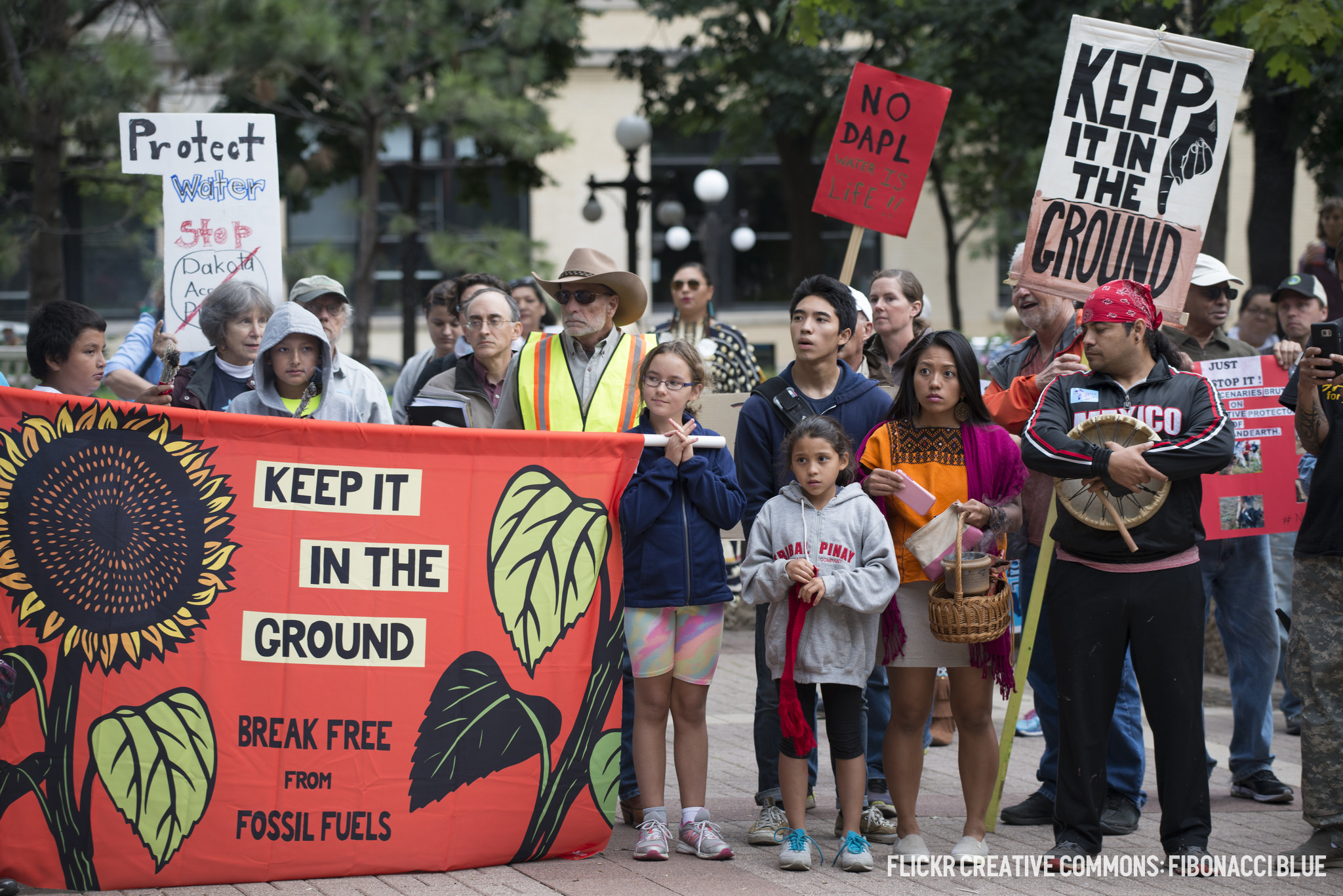
From North Dakota to Kenya, people power fights fossil fuel infrastructure
People power stopped Keystone XL in its tracks. Now we’re seeing human resistance to fossil fuel projects spreading rapidly around the globe.
“Oil and gas is a sector which depends on exploitation without responsibility, thus creating the worst form of relationship with people and the environment.” – Nnimmo Bassey

People-powered resistance to fossil fuels is sweeping the globe. Photo: Flickr Creative Commons, Fibonacci Blue.
On a panel discussing “Equity and Just Transitions” at Stockholm Environment Institute’s recent conference on supply side fossil fuel policy, Nigerian environmental activist and author Nnimmo Bassey pointed out that fossil fuel companies are incapable of operating with any sense of equity when it comes to their pursuit of oil, gas and coal exploration. It is therefore no surprise that we are witnessing a growing and powerful movement of protectors and people power stretching from North America to the Global South in areas like Lamu, Kenya.
The Dakota Access Pipeline, cutting through Standing Rock Sioux tribal land, is one stark example of the fossil fuel exploitation described by Bassey. The proposed pipeline is expected to transport up to 570,000 barrels per day of fracked crude oil across the states of North Dakota, South Dakota, Iowa, and Illinois, with additional pipelines then carrying it south to Gulf Coast refineries in Texas and Louisiana. Not only would Dakota Access lock-in the equivalent carbon emissions of 30 coal plants., but the pipeline has faced unprecedented opposition from the Standing Rock Sioux and other indigenous groups because it would be crossing sacred lands and would potentially contaminate the tribe’s main source of drinking water.
About a month ago, as construction of the pipeline continued, tensions between the involved parties rose to a new high when private security firms used dogs to intimidate and attack anti-pipeline activists. But the Standing Rock Sioux their allies stood their ground, and the Obama Administration was forced to step in as a result of this people power. The Administration issued a statement putting a temporary halt to construction of part of the pipeline, because of “important issues raised by the Standing Rock Sioux Tribe and other tribal nations and their members regarding the Dakota Access pipeline specifically, and pipeline-related decision-making generally.” Yet in spite of this statement and additional pressure from worldwide protests, the pipeline’s parent company Energy Transfer Partners has vowed to complete the project, dismissing community concerns as unfounded.
The #NoDAPL movement against Dakota Access has become one of the defining moments in the recent history of protests against fossil fuel infrastructure, but it is not an isolated case. As just one example, it builds on the strength of the people-powered #NoKXL movement against the Keystone XL Pipeline. And there are near-countless other ongoing fights: just next door to Washington, DC, Virginians are opposing Dominion Power’s proposed Integrated Resource Plan, which would increase gas-fired generation in the state. Community opposition to fossil fuel infrastructure even spans the continents: in East Africa, Kenyans are fighting what would be the region’s first coal-fired power plant.
In Kenya, Amu Power, a consortium of Gulf Energy, Centum Investment Company, and Sichuan Electric Power Company has faced hurdles in the past year as it attempts to construct a coal-fired power plant in the coastal area of Lamu County. The 1,050 MW-capacity plant is a $2 billion project financed by the state-owned Industrial Commercial Bank of China (60%) and Standard Bank of South Africa. Despite the Kenyan government’s efforts to tout potential economic benefits of the project, the plant has faced heavy opposition, particularly from a coalition of over 30 community organizations representing grassroots environmental, youth, women, and religious groups under the banner Save Lamu.
Despite an initial construction date of September 2015, the coal plant has been delayed several times due to the pressure from activists, as well as dissent from local government officials over the merits of the project. In August 2016, Samia Omar, a high government official in Lamu County, resigned over the project. In a statement to the public, she expressed, “having read the Environmental and Social Impact Assessment (ESIA) of the proposed Lamu coal power plant, I’m convinced that the project will have irreversible and profound impacts on Lamu and therefore, don’t feel I can effectively execute my mandate to both promote investor’s interests as well as that of preserving our natural resources.” Her concerns echoed those of the community-based organizations who have been vocal against the plant’s construction from the time of its announcement.
Numerous other public officials also pushed back against the plant, stating, “we hear the argument about clean coal. There is no such thing as clean coal.” Just last month, the Lamu government asked Kenya’s National Environment and Management Authority to deny the power plant a license to operate, citing found more 20 questionable aspects. The plant is being opposed on climate grounds, as well as the government’s failure to seek views of important stakeholders and properly account for the displacement of more than 600 local residents who would be impacted by the project.
In December 2015, we saw world leaders in Paris agree to limit global average temperature rise to well below 2ºC, and even push to strive to limit it to 1.5ºC. It is clear that there already is enough carbon in proposed fossil fuel projects to blow through the sky’s limit, and yet governments choose to ignore the warnings. The rejection of the Keystone pipeline last year on climate grounds was an important people-powered victory. Perhaps the #NoDAPL and #SaveLamu movements, driven by people power, will also force governments to reject new projects on climate grounds, bringing us one step closer to implementing a climate test for new fossil fuel infrastructure to keep the world aligned with the Paris climate goals.
